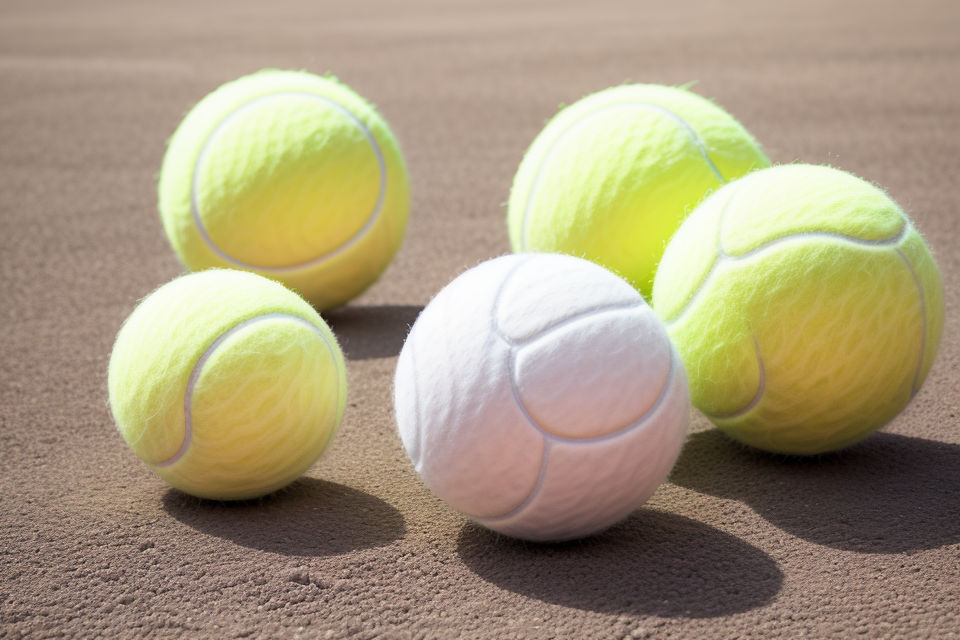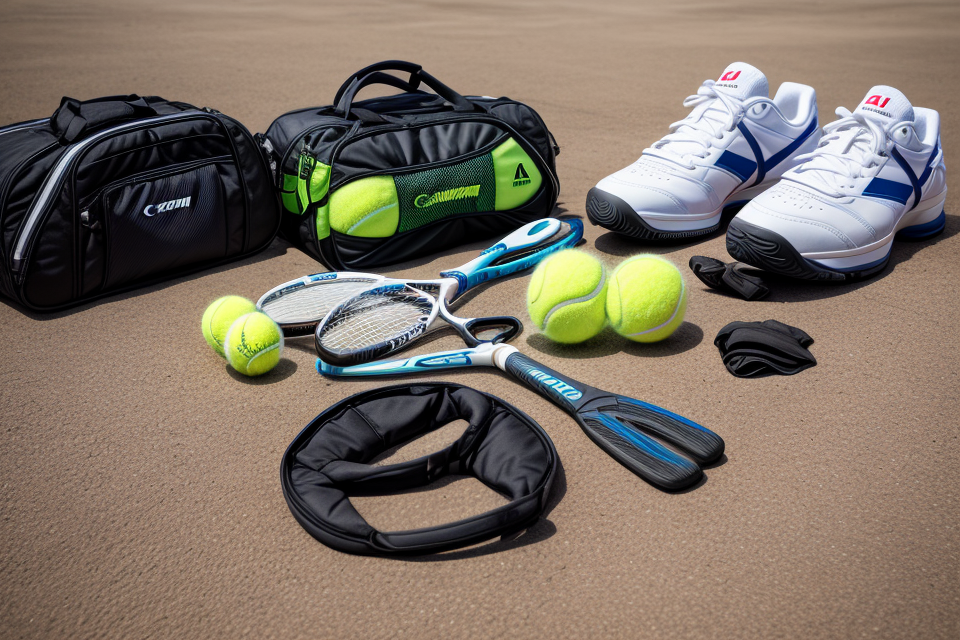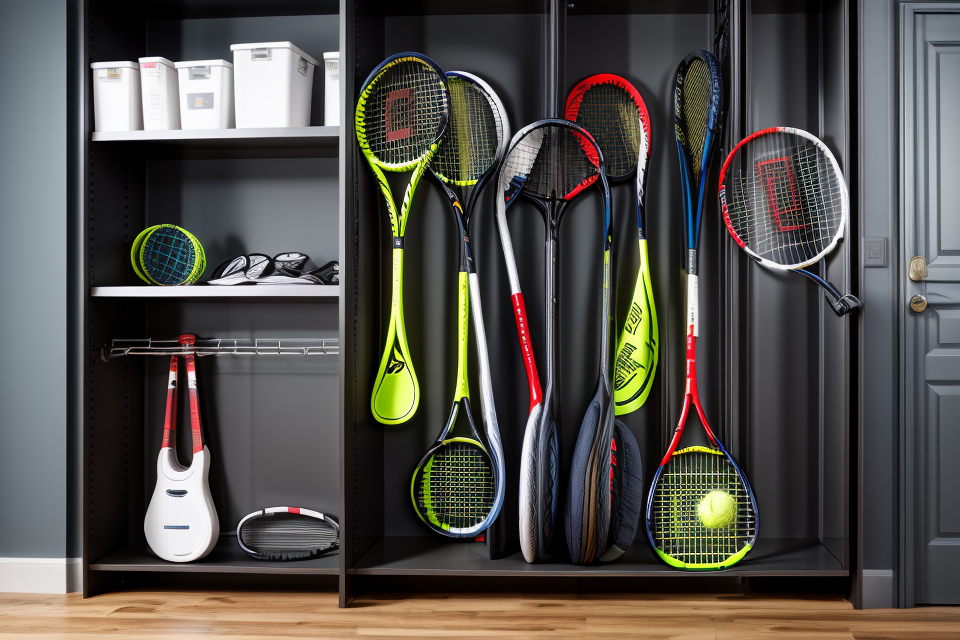Tennis balls are an essential part of any tennis game, and it’s important to take good care of them to ensure optimal performance. Proper storage and maintenance can help extend the life of your tennis balls and prevent damage. In this article, we’ll discuss the best practices for storing and maintaining tennis balls, so you can keep them in top condition for your next match. From finding the right container to rotating your balls, we’ve got you covered. So, let’s get started!
The Importance of Tennis Ball Maintenance
Factors Affecting Tennis Ball Performance
When it comes to playing tennis, the performance of the ball can have a significant impact on the outcome of the game. Here are some factors that can affect the performance of tennis balls:
- Compression: The compression of a tennis ball refers to how much it is squeezed or compressed when it is hit by a racket. If a ball is overcompressed, it will not bounce as high or travel as far as a ball that is properly compressed. On the other hand, if a ball is undercompressed, it will bounce too high and travel too far, making it difficult to control.
- Surface Dust and Debris: Over time, tennis balls can accumulate dust, dirt, and other debris on their surface. This buildup can affect the way the ball moves through the air and can make it more difficult to control. It is important to regularly clean tennis balls to ensure they are performing at their best.
- Moisture: Tennis balls can absorb moisture from the air or from being exposed to wet surfaces. When a ball absorbs too much moisture, it can become heavy and difficult to control. It can also affect the way the ball moves through the air, causing it to behave erratically. It is important to store tennis balls in a dry, well-ventilated area to prevent moisture absorption.
Why Regular Maintenance Matters
- Extends Tennis Ball Lifespan
Regular maintenance is crucial to extend the lifespan of tennis balls. The average lifespan of a tennis ball is approximately one hour of play, but with proper care, this can be increased significantly. Regular cleaning and inspection of the balls can identify any damage or wear and tear, allowing them to be removed from play before they become too soft or irregularly shaped. This helps to prevent unexpected breakage during a match, which can be frustrating and disruptive to play.
- Enhances Playability
In addition to extending the lifespan of tennis balls, regular maintenance also enhances their playability. Dirt, dust, and sweat can accumulate on the surface of the ball, affecting its bounce and overall performance. By regularly cleaning the balls, players can ensure that they maintain their optimal bounce and trajectory, resulting in improved accuracy and control during play.
- Improves Safety
Finally, regular maintenance of tennis balls improves safety for players. Balls that are not in good condition can be more unpredictable and may bounce erratically, which can lead to injuries or accidents on the court. By ensuring that balls are clean and in good condition, players can reduce the risk of accidents and injuries, allowing them to focus on their game without worrying about safety concerns.
Overall, regular maintenance of tennis balls is essential for optimal performance, safety, and longevity. By taking the time to properly store and care for their balls, players can ensure that they are always ready for play, providing a better and more enjoyable experience on the court.
Tennis Ball Storage Techniques
Proper Container and Storage Space
When it comes to storing tennis balls, it is important to choose the right container and storage space to ensure that they remain in good condition and maintain their performance. Here are some guidelines to follow:
Dry, Cool, and Dark Places
Tennis balls should be stored in a dry, cool, and dark place. This means avoiding areas that are prone to humidity, moisture, or direct sunlight. Direct sunlight can cause the balls to degrade and lose their pressure, which can affect their performance on the court.
Avoid Exposure to Direct Sunlight and Heat
Exposure to direct sunlight and heat can cause the rubber and foam components of the tennis ball to break down, leading to a loss of pressure and reduced performance. This is why it is important to store tennis balls in a cool, dry place, away from direct sunlight.
It is also important to note that storing tennis balls in a closed container can trap moisture and cause the balls to become overly soft, which can also affect their performance. Therefore, it is recommended to use a container with good ventilation, such as a breathable basket or a container with small holes.
Additionally, it is important to ensure that the storage space is clean and free of any debris or dirt, as this can also affect the performance of the tennis balls.
Overall, proper storage of tennis balls is crucial to maintaining their performance and extending their lifespan. By following these guidelines, you can ensure that your tennis balls remain in good condition and ready for use on the court.
Organizing Your Tennis Balls
Sorting by Color and Type
One effective method for organizing your tennis balls is to sort them by color and type. This makes it easy to identify the balls you need for a specific activity or match. For instance, you can group all the yellow balls together for a more challenging match, while keeping the pressurized balls separate from the non-pressurized ones. This approach also ensures that you have an adequate supply of each type of ball, reducing the chances of running out during a game.
Labeling for Easy Identification
Labeling your tennis balls is another helpful technique for keeping them organized. By assigning a specific label to each type of ball, you can easily locate the ones you need without having to search through a large collection. This approach is particularly useful when you have a large number of balls or when they are stored in different locations.
You can use labels with clear and concise descriptions, such as “Pressurized Red Ball” or “Non-Pressurized Yellow Ball,” to ensure that you can identify the balls quickly and easily. Additionally, you can use different colors or patterns on the labels to help differentiate between the various types of balls.
Overall, sorting your tennis balls by color and type and labeling them for easy identification are both effective techniques for organizing your tennis balls. By following these simple steps, you can ensure that you always have the right balls for the right occasion, and that you can quickly locate the ones you need for a game or match.
Tennis Ball Cleaning and Preparation
Removing Surface Dust and Debris
Before a tennis ball can be used for optimal performance, it is essential to remove any surface dust and debris that may affect its bounce and overall quality. Here are some effective methods for removing surface dust and debris from tennis balls:
Brushing with a Soft-Bristled Brush
One of the simplest and most effective ways to remove surface dust and debris from tennis balls is by using a soft-bristled brush. This method is especially useful for removing small particles of dirt and debris that may be embedded in the ball’s surface. To brush a tennis ball, gently insert the brush into the ball’s pile and rotate it in a circular motion. This will help to loosen and remove any particles that may be trapped in the ball’s fibers.
Gently Rolling on a Flat Surface
Another effective method for removing surface dust and debris from tennis balls is by gently rolling them on a flat surface. This method is particularly useful for removing larger particles of dirt and debris that may be stuck on the ball’s surface. To roll a tennis ball, place it on a flat surface and gently roll it back and forth. This will help to loosen and remove any particles that may be trapped in the ball’s fibers.
It is important to note that while these methods are effective for removing surface dust and debris from tennis balls, they may not be sufficient for removing deeper layers of dirt and debris. In such cases, it may be necessary to wash the ball with a mild detergent or use a specialized cleaning solution. However, it is generally recommended to avoid submerging the ball in water, as this may cause the ball to lose its pressure and become defective.
Addressing Moisture
Tennis balls, like any other sports equipment, are prone to moisture damage. Moisture can cause the ball to become heavier, change its color, and affect its overall performance. It is crucial to address moisture properly to ensure optimal performance. Here are two ways to address moisture in tennis balls:
- Allowing Tennis Balls to Dry Naturally
One way to address moisture in tennis balls is by allowing them to dry naturally. This method is recommended when there is only a small amount of moisture on the ball. To allow the balls to dry naturally, simply place them in a well-ventilated area with good air circulation. Make sure that they are not in direct sunlight or in an area where they can be easily damaged.
- Using a Tennis Ball Dryer (When Appropriate)
Another way to address moisture in tennis balls is by using a tennis ball dryer. This method is recommended when the balls are completely wet or soaked. Tennis ball dryers work by using heat and air circulation to dry the balls quickly. It is important to follow the manufacturer’s instructions when using a tennis ball dryer to avoid damaging the balls.
It is also important to note that exposing tennis balls to extreme temperatures, such as direct sunlight or a heating vent, can cause damage to the ball’s materials. Therefore, it is recommended to use a dryer that is specifically designed for tennis balls.
In conclusion, addressing moisture in tennis balls is crucial to ensure optimal performance. Whether it is by allowing the balls to dry naturally or using a tennis ball dryer, it is important to choose the appropriate method and follow the manufacturer’s instructions to avoid damaging the balls.
Inspecting and Replacing Old Tennis Balls
Visual Inspection
Inspecting the condition of your tennis balls is crucial to ensure that they are still in good shape for optimal performance. Visual inspection involves examining the exterior of the ball for any signs of wear and tear. Here are some things to look out for:
- Cracks: If you notice any cracks on the surface of the ball, it’s time to replace it. Cracks can affect the ball’s durability and performance, leading to a change in bounce and trajectory.
- Discoloration: Discoloration can occur due to exposure to sunlight or excessive use. While it may not necessarily affect the ball’s performance, it can indicate that the ball is old and may be due for replacement.
- Flat spots: Tennis balls are designed to have a uniform shape and bounce. If you notice any flat spots or unevenness on the surface of the ball, it may affect its performance and should be replaced.
- Foreign objects: Check the ball for any foreign objects such as dirt, grass, or debris that may affect its performance. Remove any visible debris before using the ball.
It’s important to note that while visual inspection is a good starting point, it may not catch all the signs of wear and tear. It’s always a good idea to give your tennis balls a spin to check for any irregularities in their bounce. Regularly inspecting and replacing old tennis balls can help ensure that you get the most out of your equipment and improve your performance on the court.
Replacement Guidelines
When it comes to replacing old tennis balls, there are certain guidelines that can help ensure optimal performance. Here are some factors to consider:
- Based on Usage and Condition: The frequency with which you replace your tennis balls will depend on how often you play and the condition of the balls. If you play frequently, you may need to replace your balls more often. Over time, the pressure-sensitive foam inside the ball will break down, causing the ball to lose its pressure and bounce. Additionally, the surface of the ball may become dirty or worn, affecting its performance.
- Frequent Inspection Recommended: To determine whether your tennis balls need to be replaced, it’s important to inspect them regularly. Check for any visible signs of wear and tear, such as cracks or discoloration. Additionally, you can use a pressure gauge to measure the pressure of the ball. If the pressure is below the recommended range, it’s time to replace the ball.
In general, it’s recommended to replace your tennis balls every six months to a year, depending on your usage and the condition of the balls. By following these replacement guidelines, you can ensure that your tennis balls are always in good condition and ready for optimal performance.
Extending Tennis Ball Life
Proper Handling and Storage
When it comes to extending the life of your tennis balls, proper handling and storage is key. Here are some tips to keep in mind:
- Avoid Dropping or Mishandling: One of the biggest culprits when it comes to shortening the life of a tennis ball is dropping it or mishandling it. This can cause the pressurized core of the ball to escape, resulting in a loss of pressure and reduced performance. To avoid this, always handle your tennis balls with care, and never drop them from great heights.
- Rotate Your Tennis Balls for Even Wear: Another way to extend the life of your tennis balls is to rotate them regularly. This means using a different ball for each match or practice session, and ensuring that each ball gets used evenly. By doing this, you can prevent any one ball from becoming overused and worn out more quickly than the others.
Additionally, it’s important to store your tennis balls in a cool, dry place, away from direct sunlight and extreme temperatures. This will help to prevent the balls from becoming deformed or losing their pressure over time.
Using a Dampener
Using a dampener is an effective way to extend the life of your tennis balls. A dampener is a small, cylindrical device that is placed inside the can of tennis balls. It helps to reduce the amount of pressure on the balls, which in turn slows down the rate at which they lose their pressure and become soft. This means that the balls will remain in good condition for longer, and you will be able to use them for more matches.
There are different types of dampeners available on the market, each with its own unique features and benefits. When choosing a dampener, it is important to consider your own needs and preferences. For example, some dampeners are designed to be used with specific types of tennis balls, while others are more versatile and can be used with a variety of different balls. Additionally, some dampeners are made from different materials, such as plastic or metal, so it is important to choose one that is durable and long-lasting.
Using a dampener is easy. Simply place it inside the can of tennis balls, and close the lid. The dampener will do the rest, helping to extend the life of your balls and keep them in good condition for longer. With proper care and maintenance, your tennis balls will last longer and perform better, allowing you to enjoy better games on the court.
FAQs
1. What is the best way to store tennis balls?
The best way to store tennis balls is in a cool, dry place with good ventilation, away from direct sunlight. Ideally, they should be stored in a tightly sealed container or bag to prevent moisture from getting in. It’s important to note that storing tennis balls in a hot car or in a damp environment can cause them to lose their pressure and become less effective.
2. How often should I replace my tennis balls?
Tennis balls should be replaced every six months to a year, depending on how often they are used. Over time, tennis balls can lose their pressure, become flat, and become less effective. If you notice that your tennis balls are not bouncing as well as they used to, it’s time to replace them.
3. Can I freeze tennis balls to make them last longer?
No, you should not freeze tennis balls as it can cause them to lose their pressure and become less effective. Freezing can also cause the rubber to become brittle and break down more quickly. It’s best to store tennis balls in a cool, dry place as recommended.
4. Can I use tennis balls that have been used before?
Tennis balls that have been used before can still be used, but they may not perform as well as new balls. Used balls may have lost some of their pressure and become less effective, so it’s important to take that into consideration when playing.
5. How can I keep my tennis balls clean?
To keep your tennis balls clean, you can wipe them down with a damp cloth after each use. If there is dirt or debris stuck on the ball, you can gently brush it off with a soft brush. Avoid using harsh chemicals or abrasive cleaners as they can damage the surface of the ball and affect its performance.



